| Article ID | Journal | Published Year | Pages | File Type |
|---|---|---|---|---|
| 624382 | Desalination | 2012 | 10 Pages |
Bench-scale ultrafiltration (UF) experiments were performed to address the effects of single‐walled nanotubes (SWNTs) on flux and rejection of humic acid (HA) during fouling runs under various hydrodynamic and solution conditions. The performance of SWNTs–UF was also evaluated on the basis of a resistance-in-series model, filtration laws, and dissolved organic matter (DOM) transportation mechanisms. The addition of SWNTs to the UF process did not significantly exacerbate the permeate flux decline and total membrane resistances. It appeared that the SWNTs did not likely increase total resistance because the HA fouling was mainly attributed to the total resistance. SWNTs–UF produced highly reduced membrane resistance per unit of retained DOM because SWNTs adsorbed some of the HA by offering binding sites. The rejection of HA increased up to 9–25% in SWNTs–UF. These results suggest that the effect of SWNTs on membrane fouling is a function of hydrodynamic and operational conditions. On the basis of a filtration law approach, intermediate blocking was more dominant in the early stages; cake filtration became more dominant as filtration progressed, with development of a fouling layer. The HA rejection trends in SWNTs–UF were observed to be higher than that in UF alone.
► We studied the removal of NOM and flux decline in SWNTs–UF systems. ► The SWNTs–UF showed more NOM removal than UF alone. ► The SWNTs–UF showed less flux-decline than UF alone.
